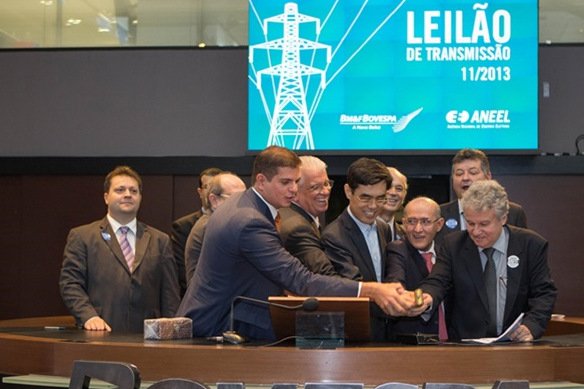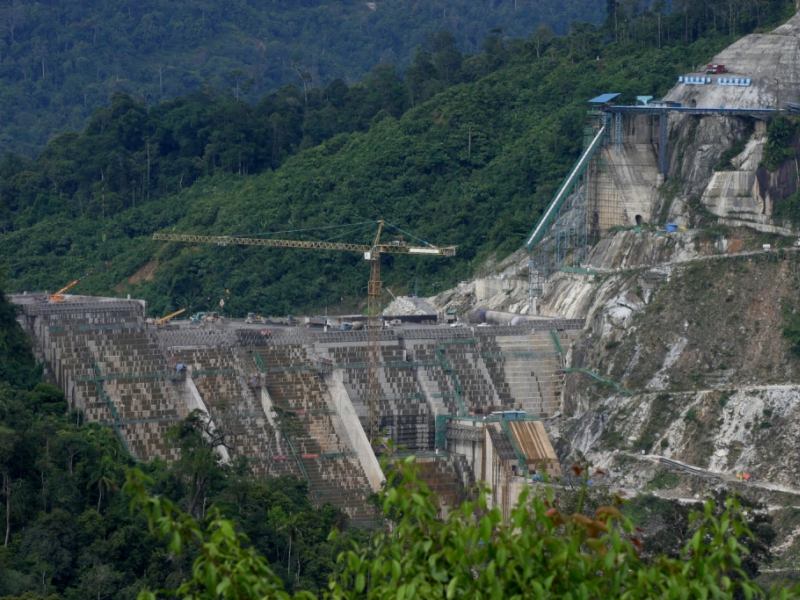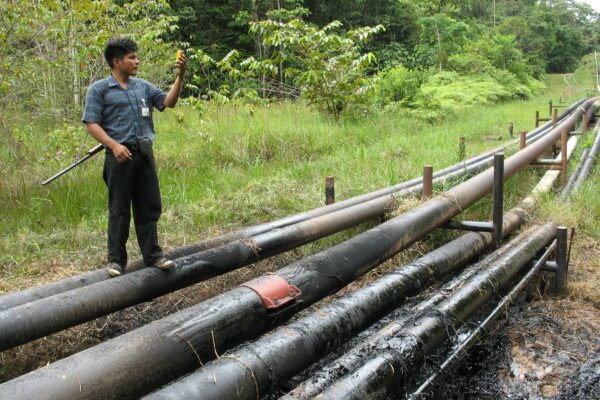
The implosion of Brazilian businesses with the Lava Jato corruption operation, the devaluing of the Real currency, and the rise in credit rates in Brazil have created an opportunity for Chinese businesses to establish greater participation in the country. Taking advantage of this situation, the China Three Gorges enterprise is preparing to make an offer on the licensing of the São Luiz do Tapajós dam project. With a potential generating capacity of 6.133 megawatts once installed, and a cost estimated at R$ 23 billion (US $ 8 billion), the dam’s environmental licensing process is the most controversial since Belo Monte. And, as it turns out, the biggest hydroelectric dam planned by the Brazilian government may be built by a Chinese business that comes with a long record of human rights violations.
The preparation of a “competitive offer” for the hydroelectric dam is in the annual report of the business. The president of China Three Gorges Brazil, Li Yinsheng, affirms that the decision will only be taken after they familiarize themselves with the conditions of the licensing offer. “CTG [China Three Gorges] chose Brazil as a priority country in its strategy for its international expansion. The company is looking at all opportunities in the country,” the executive wrote by email.
The interest of Chinese companies in the Brazilian electricity sector is confirmed by Charles Tang, president of the Brazil-China Chamber of Commerce and Industry, which provides support to Chinese companies interested in investing in Brazil. “With or without Lava Jato, China is investing here for various reasons: to occupy the market, to enjoy a profit, to export its excess capacity and to assure strategic resources, as well as for international geopolitical reasons,” says Tang. He is providing support for such projects as the hydroelectric dam, a wind power farm, and a share in two thermoelectric power plants. He alleges that he can’t say which companies are participating, due to the secrecy maintained by the Brazil-China Chamber of Commerce and Industry.
In order to understand the interest of these Chinese companies in Brazil, first we have to understand why the Chinese hydroelectric sector is crossing its national boundaries, says Stephanie Jensen-Cormier, director of the Beijing office of the NGO International Rivers. China, according to Jensen-Cormier, owns more than half the big hydroelectric dams in the world, more than Brazil, the U.S., and Canada combined. Its companies therefore now need to expand outside the country. “The Chinese state-run companies have become more sophisticated and competitive in the construction of big hydroelectric dams. They are involved in more than 330 projects in 85 countries. The majority of these are in Southeast Asia, and the number is only rising,” said Jensen-Cormier.
Amazon Basin Interests
The construction of hydroelectric dams on the Amazon River’s tributary, the Tapajós River, is interwoven with other Chinese business interests in the region. Low-cost energy could help the establishment of its mining projects in the region, another sector of Chinese interests, according to the Brazilian book “Made in China,” by the sociologist Camila Moreno. The author points out that the Tapajós holds reserves of minerals that are more and more sought after by the Asian country. “In the last years, the discovery of new mining sites shot up rapidly, and now the region is the big promise on the frontier of exploration for diamonds.” Associated with the construction of dams’ canal locks, the series of hydroelectric dams could decrease delivery costs of Brazilian soy bought by Chinese companies.
The hydroelectric project Tapajós-Teles Pires (referring to the two rivers by those names) would link the soy plantations in Mato Grosso by a river pathway that would go all the way to the Amazon River, which discharges into the international port of Belém near the Atlantic Ocean. The new project also could be complemented by the Nicaraguan canal, which China is working on opening in that country, slated to link the Atlantic and Pacific oceans, thus shortening the length of the route of delivery of Brazilian soy to Asia.

In addition to the integration of the region’s rivers, China also is going forward with other land route corridors for exports. The state-run enterprises Cheng Dong International and China Harbor have a project to link Surinam and Manaus, including the construction of a deepwater port, a train station and a bus station, thus reducing the necessity of river navigation. Author Camila Moreno affirms that these investments signal the definitive entry of China into the Amazon region.
The president of the Brazil-China Chamber of Commerce and Industry contends that the investments in hydroelectric dams, waterways, and mining in the region are not necessarily connected. Charles Tang said that, in the majority of cases, the businesses invest only based on a good return on a project. But this wouldn’t exclude cooperation and strategic partnerships between these different companies, given that all of them have a single boss: the Chinese government.
Chinese Expansion
The China Three Gorges Corporation is already the sixth largest energy operator in Brazil, with 6,895 kilowatts of installed capacity, enough to supply Pernambuco State alone. The company’s expansion in Brazil jumped up in November 2015, when it was awarded the concession for the Jupiá and Ilha Solteira hydroelectric dams, which belong to the São Paulo energy company, the Companhia Energética de São Paulo. The Chinese company paid the minimum value for the authorization, R$ 13.8 billion (U.S. $ 3.5 billion).

From there, the company’s expansion in Brazil was rapid. The China Three Gorges Corporation entered Brazil in 2011, in an indirect manner. It was when the Chinese company bought from Portugal’s government its share in Energias de Portugal (EDP), making it the largest stakeholder, owning 21.35% of the business. In this way, the China Three Gorges Corporation inherited the projects of seven hydroelectric dams in Brazil.
The corporation’s presence was strengthened in 2014, during the visit of Chinese president Xi Jinping to Brazil. In the event, the Chinese government assigned a technical cooperation agreement with Eletrobras Furnas, a mixed-capital, publically held company whose controlling stake is held by the Brazilian government.

This was when the interest of the two companies in the São Luiz do Tapajós dam license was announced. Asked to comment, Eletrobras Furnas will only affirm that the accord provides for the construction of the São Manoel dam (700 megawatts), to be located on the Teles Pires River, on the boundary between Pará and Mato Grosso states.
In a note, the Brazilian enterprise declares that the accord provides for the “development of new hydroelectric dam projects in Brazil, as well as for the technical cooperation and exchange of technologies.” The government also confirms that it “foresees the possibility of participation of Furnas in new undertakings in alternative energy sources, especially wind power, in Brazil and in China.” Repórter Brasil asked for details on the cooperation between the two companies and access to the text of the accord, but the enterprise alleged that, with reference to company information, this is an “exception set forth” in the federal law on transparency and access to public government information.
After the accord with Furnas, in 2015 the China Three Gorges Corporation acquired three businesses that are owned by Triunfo Participações e Investimentos, in an agreement that amounted to R$ 1.72 billion (U.S. $ 435 million). Between them they operate the Salto hydroelectric plant (116 megawatts), in Goiás state, and the Garibaldi hydroelectric plant (192 megawatts), in Santa Catarina.
The CTG Corporation is operating thus far in 5 wind farms (328 megawatts), with two of them still in construction. Beyond those, Three Gorges also is responsible for 50 % of the Santo Antônio do Jari hydroelectric plant (373.4 megawatts) and the Cachoeira Caldeirão hydroelectric dam, (219 megawatts), both in Amapá state.
In just a few years, the Three Gorges Corporation has leapt ahead of State Grid, the other Chinese state-run operation in Brazil, which is the biggest electrical sector enterprise in the world. State Grid already has made a similar expansion. Within a few years of its arrival in Brazil in 2010, State Grid acquired companies that operated in Brazil along with concessions for different lines of transmission.
The company’s biggest jump happened when State Grid won the license to construct the so-called “Big Line” of electrical transmission, the biggest transmission line in the country. Part of the construction will be made by the Chinese together with the Brazilian companies Furnas and Eletronorte. The second part of the line, though, will be made exclusively by the Chinese. In order to construct these factories, the business is counting on the money from the Brazilian government. The BNDES (Brazilian Development Bank) can finance up to 70 % of the project, with part of it financed by long term interest rates, credit subsidized by the government at below-market values.
History of Human Rights Violations

The China Three Gorges Corporation arrived in Brazil almost 20 years after having been founded for the construction of the biggest hydroelectric plant in the world, the Three Gorges Dam on the River Yangtze in China. The plant was only put online at the end of the past decade after more than 15 years of construction. Today the enterprise has contracts in more than 40 countries, with 89 construction projects in progress, according to its most recent report from 2014.
In the 90s, human rights organizations were already pointing to problems in the Three Gorges Corporation’s activities. In a 1995 report, Human Rights Watch was already contending that the site was a window into problems with openness and reform in China, and could be “a model of how a lack of transparency and debate, authoritarian decision processes, and unjust work conditions can stain an ambitious enterprise.”
The Murum hydroelectric plant in Malaysia by the Malaysian State government experienced human rights violations and experienced problems related to resettlement. China Three Gorges was involved in this project as a contractor.
This history is especially worrying for Brazil, considering that one of the biggest debates around the licensing process is, justifiably, the violation of the rights of local peoples. The Federal Public Ministry of Pará state has already filed suits to demand the suspension of the dam licensing process so long as these local communities have not been consulted on the dam works, as determined by International Labor Organization’s Convention 169, to which Brazil is a signatory.
Labor questions involving immigrants are also a problem of this Chinese enterprise when operating in Malaysia, according to the report. This is another worrying element in the Amazon, where the construction sites of these giant dams attract Haitians, Africans, and internal migrants from all over Brazil.

In the construction of the Chinese plant in Malaysia, Indonesian workers complained that their passports were confiscated, and that the conditions were different from those agreed upon beforehand. The Indonesians also confirmed that they needed to buy their own helmets and rubber boots, and that they didn’t possess any accidents insurance. Moreover, the workers were charged for any medical care they required while working on the project.
In an email sent to our reportage team, China Three Gorges Corporation asserts that “In addition to its own internal policies, CTG follows all the law of the countries in which it operates. The company holds as its global premise a respect for the communities around its hydroelectric plants and a promise of development in the regions where it acts.”
In spite of this history of rights violations, the director of the International Rivers’ Beijing office says that the company has standards that are better than those of other companies in the country. “China Three Gorges has been active in the international market for more than nine years. They make projects with social and environmental standards that are a bit better than those of other Chinese companies.” According to Jensen-Cormier, the Brazilians should pay attention to their own government and the companies that will be associated with the Three Gorges company. “If the government brings a high standard to bear here, the Three Gorges company will make an effort to take measures to reach that standard even if it’s not easy. If the Brazilian government brings low [environmental and rights] standards, the company can try to take advantage of that situation,” said Jensen-Cormier. “At the same time, local partner companies have a big impact on the performance of the company with regards to compliance with federal laws and local regulations.”
She cited the example of the construction of the Coca Codo Sinclair hydroelectric dam in Ecuador by the Chinese company Sinohydro. In a comparative study of seven plants constructed by Chinese state-run companies by International Rivers, this was the case with fewer instances of non-compliance. This happened thanks to strong local laws, applied in a satisfactory manner.
Broken Rules
In addition to laws of countries that receive investments, another important regulatory factor is the laws of financial backers. Director of the China-Latin America Sustainable Investment Initiative (CLASII), a research center based in Washington, Paulina Garzón says that, in theory, the rules of the Chinese banks are good. “In theory, the legal system with regards to the environment is good. It has aspects that are more advanced than those of other banks.” Garzón cites as an example Exim Bank, a Chinese development bank aimed at the promotion of imports and exports, and a possible financier of future construction projects in Brazil. The bank demands an impact study for all investments to be made on its credit, in addition to maintaining a record of its creditors’ history of socio-environmental impacts.
The application of these standards, however, can be much different than what’s on paper. “The problem with the Chinese rules is that they are not obligatory, there’s not any more information available on them, and there is no communication with the affected communities so you can know what’s happening,” she says, lamenting that contact with those peoples affected by Chinese government bodies and businesses is very difficult.
Even in the face of these restrictions, Garzón emphasizes that pressuring the Chinese financial backers for these regulations to be followed is a tool for these companies to maintain proper standards with a view to stressing these rules in their own countries.
With such regulations often not being followed (both Chinese and local rules), in 2015 communities throughout Latin America entered into more conflicts with Chinese companies, according to a report that Garzón discussed. In Nicaragua, protests demanded the cancelation of the construction of the Chinese canal. In Argentina, people questioned agreements made with China for the creation of research bases in Patagônia and the construction of canals in state of Entre Rios. And in Peru, the protests against the Chinese mining company MMG resulted in the deaths of four people. And finally, indigenous movements questioned the activities of Ecuacorriente, also a Chinese company, in the Inter-American Court of Human Rights.
The Tapajós basin appears to be one more episode in this larger dispute. The environmental impact study, produced by Eletrobras and other national and international companies, was presented to IBAMA [Brazil’s federal environmental agency] in August 2014. This study was found to be inconsistent. Human rights organization criticize the project and its studies, pointing to various risks not covered in the study, such as the flooding of indigenous lands and the loss of fish, essential for the life of the riverbank peoples and the indigenous peoples in the region.
IBAMA asked the group to redo the impact studies, but Eduardo Braga, the minister of Mines and Energy, affirmed that the environmental license should be approved in the first six months of 2016. The dam’s auction is expected to occur in second half of 2016. The government’s rushing of the [dam’s environmental licensing and auction] process seems to be one more factor potentially aggravating conflicts in the region.
The fast tracked licensing process for the dam may intensify the collision between the interests of construction companies and that of local communities, thus repeating what has already happened in other places in Brazil and throughout Latin America. Considering that the indigenous peoples and traditional communities in the entire Amazon basin have difficulty defending their rights when impacted by national consortiums, as in the case of the Belo Monte dam, China Three Gorges Corporation’s socio-environmental rights record raises a serious warning about the ways that enormous changes planned for the Tapajós basin will be conducted.
Translated by Tiffany Higgins















